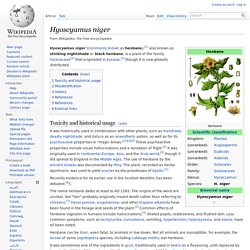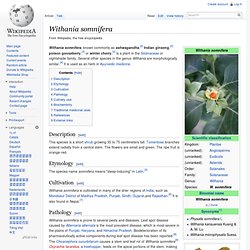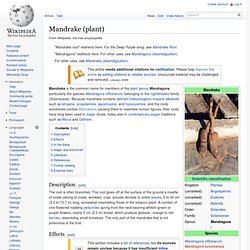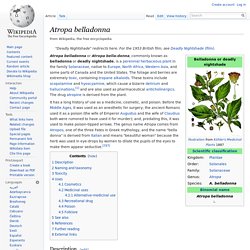

Hyoscyamus niger. Hyoscyamus niger (commonly known as henbane),[1] also known as stinking nightshade or black henbane, is a plant of the family Solanaceae[1] that originated in Eurasia,[1] though it is now globally distributed.

Toxicity and historical usage[edit] Recently evidence for its earlier use in the Scottish Neolithic has been debated.[6]). The name henbane dates at least to AD 1265. Duboisia hopwoodii. Duboisia hopwoodii is a shrub native to the arid interior region of Australia. Common names include pituri, pitchuri thornapple or pitcheri.[1] It has an erect habit, usually growing to between 1 and 3 metres in height and has long, narrow leaves.[2][3] Flowers are white and bell-shaped with violet-striped throats.[3] These appear between June and November in the species native range followed by purple-black, rounded berries which are 3 to 6 mm in diameter.[1][2]
Nicotiana rustica. Nicotiana rustica, known in South America as mapacho and in Vietnam as thuoc lao (thuốc lào), is a plant in the Solanaceae family. It is a very potent variety of tobacco. The high concentration of nicotine in its leaves makes it useful for creating organic pesticides. In Russia, N.rustica is called "makhorka" (махорка). Solanaceae. The name Solanaceae derives from the genus Solanum, "the nightshade plant". The etymology of the Latin word is unclear. The name may come from a perceived resemblance of certain solanaceous flowers to the sun and its rays. At least one species of Solanum is known as the "sunberry". Alternatively, the name could originate from the Latin verb solari, meaning "to soothe", presumably referring to the soothing pharmacological properties of some of the psychoactive species of the family. The family has a worldwide distribution, being present on all continents except Antarctica.
The Solanaceae include a number of commonly collected or cultivated species. Withania somnifera. Fruits Withania somnifera, known commonly as ashwagandha,[2] Indian ginseng,[3] poison gooseberry,[3] or winter cherry,[2] is a plant in the Solanaceae or nightshade family.

Several other species in the genus Withania are morphologically similar.[4] It is used as an herb in Ayurvedic medicine. Description[edit] This species is a short shrub growing 35 to 75 centimeters tall. Tomentose branches extend radially from a central stem. Mandrake (plant) The alkaloid chemicals contained in the root include atropine, scopolamine, and hyoscyamine.

These chemicals are anticholinergics, hallucinogens, and hypnotics.Anticholinergic properties can lead to asphyxiation. Ingesting mandrake root is likely to have other adverse effects such as vomiting and diarrhea. The alkaloid concentration varies between plant samples, and accidental poisoning is likely to occur.[1] Two references to דודאים (dûdã'im)—literally meaning "love plant"—occur in the Jewish scriptures. The Septuagint translates דודאים (dûdã'im) as μανδραγόρας (mandragoras), and Vulgate follows Septuagint. 14 And Reuben went in the days of wheat harvest, and found mandrakes in the field, and brought them unto his mother Leah.
The final verses of Song of Songs (Song of Songs 7:12–13), are: לְכָ֤ה דֹודִי֙ נֵצֵ֣א הַשָּׂדֶ֔ה נָלִ֖ינָה בַּכְּפָרִֽים׃ נַשְׁכִּ֙ימָה֙ לַכְּרָמִ֔ים נִרְאֶ֞ה אִם פָּֽרְחָ֤ה הַגֶּ֙פֶן֙ פִּתַּ֣ח הַסְּמָדַ֔ר הֵנֵ֖צוּ הָרִמֹּונִ֑ים שָׁ֛ם אֶתֵּ֥ן אֶת־דֹּדַ֖י לָֽךְ׃ Nicotiana. Etymology[edit] The word nicotiana (as well as nicotine) was named in honor of Jean Nicot, French ambassador to Portugal, who in 1559 sent it as a medicine to the court of Catherine de' Medici.[4] Cultivation[edit] Ecology[edit] Despite containing enough nicotine and/or other compounds such as germacrene and anabasine and other piperidine alkaloids (varying between species) to deter most herbivores,[5] a number of such animals have evolved the ability to feed on Nicotiana species without being harmed.
Nonetheless, tobacco is unpalatable to many species and therefore some tobacco plants (chiefly Tree Tobacco, N. glauca) have become established as invasive species in some places. Atropa belladonna. Atropa belladonna or Atropa bella-donna, commonly known as belladonna or deadly nightshade, is a perennial herbaceous plant in the family Solanaceae, native to Europe, North Africa, Western Asia, and some parts of Canada and the United States.

The foliage and berries are extremely toxic, containing tropane alkaloids. These toxins include scopolamine and hyoscyamine, which cause a bizarre delirium and hallucinations,[1] and are also used as pharmaceutical anticholinergics. The drug atropine is derived from the plant. It has a long history of use as a medicine, cosmetic, and poison. Before the Middle Ages, it was used as an anesthetic for surgery; the ancient Romans used it as a poison (the wife of Emperor Augustus and the wife of Claudius both were rumored to have used it for murder); and, predating this, it was used to make poison-tipped arrows. Description[edit] Atropa belladonna is a branching herbaceous perennial, often growing as a subshrub, from a fleshy rootstock.
Datura. Some South American plants formerly thought of as Datura are now treated as belonging to the distinct genus Brugmansia[1] (Brugmansia differs from Datura in that it is woody, making shrubs or small trees, and it has pendulous flowers, rather than erect ones). Other related genera include Hyoscyamus and Atropa.
- Burncoose Nurseries - plants by mail order direct to you - Camellia, Magnolia and Rhododendron Specialists.